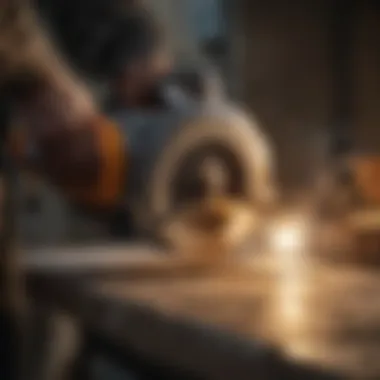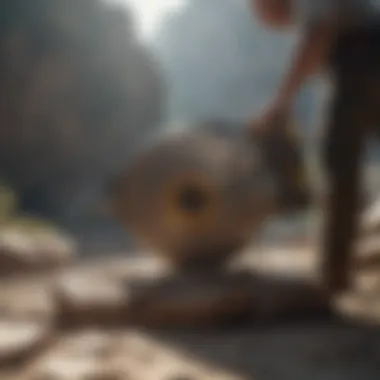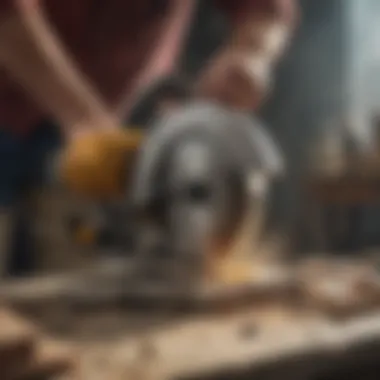Unleashing the Power of Electric Stone Cutting Saws: A Definitive Guide for Rock and Fossil Collectors


Rock and Fossil Identification
In the realm of rock and fossil collection, proper identification is paramount. Understanding the various types of rocks and fossils is fundamental to building a comprehensive collection. Rocks can range from igneous, sedimentary, to metamorphic, each with distinct characteristics and formations. Fossils, on the other hand, can include plant remains, marine organisms, or even dinosaur bones. When embarking on the journey of identification, collectors should pay close attention to specific features such as color, texture, and mineral composition to discern one specimen from another. Utilizing tools like magnifying glasses, UV lights, and hardness testing kits can further aid in the identification process, adding a layer of precision to the collector's discernment.
Collecting Tips and Techniques
For avid rock and fossil collectors, mastering the art of collecting is an ongoing pursuit. Best practices in collecting involve conducting thorough research on prime geological sites, taking into account factors such as geological history and mineral composition. Locating these coveted sites requires a keen eye for geological formations and an understanding of the geological processes that yield fossil-rich areas. Once on-site, collectors should exercise caution and employ safe extraction techniques to ensure the integrity of specimens remains intact. This may involve delicate excavation methods, such as using brushes and chisels to carefully unearth fossils without causing damage.
Preservation and Display
Preservation lies at the heart of maintaining the longevity of rock and fossil collections. Employing techniques such as stabilizing, consolidating, and protective coatings can safeguard specimens from deterioration over time. Proper storage methods are equally crucial, with considerations for humidity levels, temperature control, and protection from light exposure. When it comes to displaying these geological treasures, collectors have the opportunity to showcase their specimens in creative and aesthetically pleasing ways. From custom-built display cases to thematic arrangements, the art of presentation can elevate the visual appeal of collections, drawing admiration and intrigue.
Geological Insights
Delving deeper into the world of geology offers enthusiasts valuable insights into the Earth's history and evolution. Understanding geological formations and processes sheds light on the intricate dance of earth forces that have sculpted landscapes and preserved fossils for eons. Exploring the historical significance of rocks and fossils unveils captivating narratives of prehistoric life and ancient environments. Moreover, studying notable discoveries in the field provides inspiration and a deeper appreciation for the work of paleontologists and geologists who have unearthed invaluable contributions to science and our understanding of the planet's rich geological tapestry.
Introduction to Electric Stone Cutting Saw
Electric stone cutting saws are indispensable tools for rock and fossil collectors, revolutionizing the way enthusiasts shape and mold their geological specimens. Within the realm of this comprehensive guide, the focus lies on unraveling the intricacies surrounding electric stone cutting saws. From uncovering the fundamental principles of operation to delving into the myriad benefits and considerations, this section sets the stage for an informative exploration of these cutting-edge devices.
Understanding the Functionality
Components of an Electric Stone Cutting Saw
Electric stone cutting saws comprise a plethora of integral components that synergistically work towards achieving unparalleled precision and efficiency in stone cutting. From robust blades to sturdy motors, each element plays a pivotal role in enhancing the overall functionality of the saw. The high-quality materials used in crafting these components ensure durability and reliability, making them a prime choice for rock and fossil collectors seeking exceptional cutting performance.
Working Mechanism
The working mechanism of an electric stone cutting saw is a symphony of mechanical precision and technological innovation. The seamless integration of motor power with blade design allows for seamless cutting across various stone types, ensuring a seamless and accurate cutting experience. While the mechanism boasts efficiency and ease of operation, it's crucial to understand the intricacies to leverage its advantages effectively.
Benefits of Using Electric Stone Cutting Saw
Efficiency in Cutting
Efficiency in cutting is a hallmark feature of electric stone cutting saws, enabling collectors to trim and shape stones with unparalleled speed and accuracy. The precision offered by these saws ensures minimal wastage of material, maximizing the utility of each cut. This efficiency streamlines the cutting process, leading to higher productivity and superior outcomes.
Precision and Accuracy


Precision and accuracy are non-negotiable features when it comes to stone cutting, a promise that electric stone cutting saws deliver without compromise. The ability to achieve intricate cuts with razor-sharp accuracy elevates the quality of finished pieces, making these saws a prized possession for collectors aiming for perfection in their craft.
Versatility in Stone Types
The versatility of electric stone cutting saws extends to accommodating a wide range of stone types, from the robust resilience of granite to the delicate beauty of obsidian. This adaptability ensures collectors can explore a multitude of materials without limitations, unleashing their creativity and experimentation. The flexibility to work with diverse stone types adds a layer of excitement and exploration to the cutting process, enriching the collector's experience.
Types of Stones Suitable for Cutting
Granite
Granite, known for its hardness and durability, poses a challenging yet rewarding material for cutting with electric stone cutting saws. Its resilience demands a robust saw capable of withstanding the rigors of granite cutting, making it a preferred choice for collectors seeking a test of skill and precision.
Marble
Marvelous marble, with its elegance and grace, finds its perfect match in electric stone cutting saws that delicately sculpt its veined surfaces. The smooth cuts achieved through these saws bring out the intricate patterns and colors of marble, turning each piece into a masterpiece of artistry and finesse.
Limestone
Limestone, a versatile stone with a soft texture, offers a contrasting cutting experience with electric stone cutting saws. The malleability of limestone allows for intricate shaping and detailing, making it a favored choice for collectors exploring creative designs and elaborate cuts.
Obsidian
Exotic obsidian, with its glossy sheen and natural beauty, presents a captivating challenge for cutting with electric stone cutting saws. The precision required to work with this delicate material highlights the prowess of these saws in handling even the most intricate of cuts, showcasing the collector's skill and dedication to their craft.
Choosing the Right Electric Stone Cutting Saw
Choosing the right electric stone cutting saw holds paramount importance in the context of rock and fossil collection. Rock and fossil enthusiasts understand the significance of precision cutting and efficient tools to enhance their collection techniques. In this article, we delve into the specific elements that define a suitable electric stone cutting saw for individuals looking to elevate their geological specimen curation.
Factors to Consider
Blade Size and Material
The blade size and material play a crucial role in the effectiveness of an electric stone cutting saw. Opting for the appropriate blade size ensures the desired outcome of the cutting process. High-quality materials like diamond-coated blades enhance durability and cutting efficiency, making them a popular choice among collectors for their reliability and longevity.
Motor Power
The motor power of an electric stone cutting saw directly influences its performance. Higher motor power results in smoother and quicker cuts, particularly when dealing with hard stones. The ability to adjust the motor power according to the stone type contributes to the precision and efficiency of the cutting process.


Safety Features
Safety features are non-negotiable when selecting an electric stone cutting saw. Features like blade guards, emergency stop buttons, and overload protection ensure user safety during operation. Prioritizing safety features not only protects the operator but also prolongs the lifespan of the equipment, making it a prudent choice for rock and fossil collectors.
Top Brands in the Market
Diamond Products
Diamond Products are renowned for their superior quality and performance in the stone cutting industry. The key characteristic of Diamond Products lies in their use of high-grade diamonds for enhanced cutting precision. With a reputation for durability and efficiency, Diamond Products are a favored choice among collectors seeking top-notch cutting tools.
Makita
Makita stands out for its durability and reliability in the power tool market. The key characteristic of Makita products is their robust build quality, ensuring longevity and consistent performance. Makita's electric stone cutting saws are known for their power and precision, making them a popular choice for users seeking professional-grade equipment.
DEWALT
DEWALT exemplifies innovation and functionality in electric stone cutting saws. The key characteristic of DEWALT products is their advanced technology and user-friendly design. DEWALT saws are lauded for their efficiency and versatility, catering to a wide range of cutting needs. Collectors looking for cutting-edge tools often opt for DEWALT for its quality and durability.
Budget-Friendly Options
Entry-Level Models for Beginners
Entry-level models provide beginners with an affordable option to kickstart their stone cutting journey. The key characteristic of entry-level models is their user-friendly features and straightforward operation, ideal for those new to the craft. While they may lack some advanced functions, entry-level models offer a cost-effective solution for beginners exploring stone cutting.
Value-for-Money Choices
Value-for-money choices strike a balance between quality and affordability, offering users a competitive option without compromising on performance. The key characteristic of value-for-money choices is their efficient cutting capabilities at a reasonable price point. These models cater to both beginners and experienced collectors looking for cost-effective yet reliable electric stone cutting saws.
Safety Measures and Best Practices
Safety measures and best practices are paramount when it comes to using an electric stone cutting saw. In this article tailored for rock and fossil collectors, understanding and implementing safety measures ensure a smooth and secure cutting process, safeguarding both the user and the geological specimens. By focusing on specific elements such as Personal Protective Equipment (PPE), individuals can enhance their cutting experience while mitigating risks.
Personal Protective Equipment (PPE)
Safety Glasses
Safety glasses play a crucial role in protecting the eyes from potential hazards like stone chips and debris during cutting operations. Their impact-resistant lenses and wrap-around design provide comprehensive eye protection, ensuring clarity of vision and preventing injuries. A popular choice for enthusiasts, safety glasses with UV protection and anti-fog coating offer enhanced visibility and comfort during extensive cutting tasks. It is essential to consider the durability and fit of safety glasses, as well as their ability to withstand high-velocity impacts - key features that make them indispensable for rock and fossil collectors using electric stone cutting saws.


Gloves
Gloves are essential in maintaining a secure grip on the stone cutting saw while providing protection against cuts, abrasions, and heat generated during cutting processes. By selecting gloves with appropriate materials like leather or cut-resistant fiber, users can ensure both safety and dexterity. The ability of gloves to offer a balance between protection and tactile sensitivity makes them a valuable asset for collectors engaging in intricate cutting tasks. It is vital to assess the breathability and flexibility of gloves, considering their advantages in prolonged usage and diverse stone cutting operations.
Ear Protection
Ear protection serves as a critical component in preserving auditory health during the operation of electric stone cutting saws. By reducing the exposure to high levels of noise generated by the saw's motor and cutting process, ear protection like earmuffs or earplugs prevent hearing damage and fatigue. The emphasis on comfort and noise reduction capabilities distinguishes quality ear protection options, ensuring users can focus on precision cutting without compromising their well-being. Understanding the noise reduction rating and comfort features of ear protection aids collectors in selecting the most suitable gear for their cutting ventures.
Tips for Efficient Stone Cutting
Efficiency in stone cutting is paramount for rock and fossil collectors aiming to enhance their collection methods. By focusing on precision and efficiency, enthusiasts can achieve optimal results while preserving the integrity of geological specimens. In this article, we delve into essential tips for efficient stone cutting to elevate the cutting experience.
Techniques for Precision Cuts
Marking and Measuring
Marking and Measuring play a fundamental role in achieving precision cuts when using an electric stone cutting saw. By carefully marking the stone and measuring the required dimensions, collectors ensure that each cut is accurate and meets their specifications. The key characteristic of Marking and Measuring is the meticulous planning and attention to detail it demands. This technique is highly beneficial in ensuring that the final cut meets the desired shape and size, essential for collectors looking to showcase the natural beauty of stones. One unique feature of Marking and Measuring is its ability to reduce wastage by accurately determining the cutting area, maximizing the use of stones. However, a potential disadvantage is the time-consuming nature of this technique, especially when dealing with intricate designs.
Slow and Steady Cutting
Slow and Steady Cutting is another vital aspect of achieving precision cuts with an electric stone cutting saw. This method emphasizes the importance of controlled and deliberate cutting motions to maintain accuracy throughout the cutting process. The key characteristic of Slow and Steady Cutting is the focus on gradual movements to prevent errors and ensure a smooth finish. It is a popular choice for this article as it aligns with the goal of preserving the natural beauty of geological specimens through careful cutting. The unique feature of Slow and Steady Cutting is its ability to reduce chipping and splintering, resulting in clean and precise cuts. While the advantages of this method include improved accuracy and reduced material wastage, a potential disadvantage is the extended time required for cutting, making it less suitable for projects with strict deadlines.
Maintaining Blade Sharpness
Regular Cleaning and Maintenance
Regular Cleaning and Maintenance of the cutting blade is essential for ensuring consistent cutting performance. By regularly cleaning the blade to remove debris and applying maintenance procedures, such as lubrication, collectors can prolong the blade's lifespan and maintain its sharpness. The key characteristic of Regular Cleaning and Maintenance is the preventive care it offers to the blade, reducing the risk of damage and maintaining its cutting efficiency. This practice is a beneficial choice for this article as it emphasizes the importance of keeping equipment in optimal condition for effective stone cutting. A unique feature of Regular Cleaning and Maintenance is its ability to prevent rust and corrosion, extending the blade's usability. However, a potential disadvantage could be the time and effort required for regular upkeep.
Replacing Dull Blades
Replacing Dull Blades is a crucial aspect of maintaining efficient stone cutting results. Dull blades can lead to jagged cuts, increased energy consumption, and potential safety hazards. By promptly replacing dull blades with sharp ones, collectors can ensure consistent and precise cutting performance. The key characteristic of Replacing Dull Blades is the immediate improvement in cutting quality and efficiency. This method is a popular choice for this article as it directly contributes to achieving optimal cutting results and preserving the integrity of geological specimens. The unique feature of Replacing Dull Blades is the enhancement in cutting speed and accuracy, resulting in cleaner cuts and reducing the risk of accidents. While the advantages of this practice include improved performance and safety, a potential disadvantage could be the cost involved in frequently replacing blades to maintain cutting quality.
Conclusion
Elevating Your Rock and Fossil Collection
Innovative Cutting Techniques
Innovative Cutting Techniques emerge as a pivotal aspect within the realm of electric stone cutting saws for rock and fossil collectors. This cutting-edge approach revolutionizes traditional stone cutting methodologies by introducing advanced techniques that enhance precision and optimize cutting efficiency. The key characteristic of Innovative Cutting Techniques lies in their ability to push the boundaries of craftsmanship, allowing artisans to achieve unparalleled detailing and intricate designs in their stone creations. What sets Innovative Cutting Techniques apart is their seamless integration of technology and craft, resulting in superior cutting accuracy and finesse. While this approach offers unmatched precision and intricacy in stone cutting processes, careful consideration must be given to the complexity and skill required to master these techniques, making them a popular choice among seasoned enthusiasts seeking to elevate their craftsmanship.
Preserving Geological Beauty
Preserving Geological Beauty stands as a fundamental aspect in the electrifying world of stone cutting for rock and fossil collectors. This element underscores the importance of maintaining the natural allure and authenticity of geological specimens throughout the cutting process. The key characteristic of Preserving Geological Beauty lies in its commitment to safeguarding the inherent beauty and geological significance of rocks and fossils, ensuring that each cut enhances rather than diminishes their aesthetic value. What makes Preserving Geological Beauty a popular choice is its emphasis on sustainability and respect for nature, allowing collectors to create stunning pieces without compromising the integrity of their specimens. While this approach offers an ethical and aesthetically pleasing way to work with geological materials, it requires meticulous attention to detail and a deep appreciation for the geological wonders being preserved, making it a cornerstone of ethical stone cutting practices in this article.







